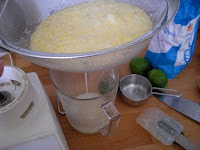There is almost nothing as satisfying to me as walking out my backdoor and harvesting a weeks worth of produce, at almost no cost. Lettuce, cucumbers, green beans, zucchini, summer raspberries, tomatoes and herbs, all abundant and ready for picking in my backyard urban garden. Since we built our raised beds last year, there have been very few costs associated with growing food this year; a few bags of nutrients to amend the soil, some pouches of seeds, and a little bit of (pleasurable) work every few days. We didn't spend more than $75 and have gotten a whole lotta return on our investment!
(check out one of the more bountiful evening harvests from this month, below)
Beyond just the money we save, the impact that it has on my children, and the neighborhood kids who stop by to munch is unquestionable. They love the fresh vegetables, and enjoy picking them too (notice my son hugging the tomato plant, he actually told me to wait to take the picture so he could do that...) It doesn't get much better than this.
In recent years, the urban gardening and local food movement have been largely associated with middle or upper middle class white folks. This should not, and need not be the case. Growing food used to be a necessity for poor people, but with urbanization, the establishment of housing projects, and generations of knowledge being lost, both about growing and cooking food, well, it is going to take some work to bring this process back into the lives of the general public, but it is happening now across the country, and will continue on, I have no doubt.
I recently attended an event at Common Ground High School where I spoke with a parent of one of the students. She said she now grows food at home, inspired by her son. For every school garden or urban farm there are dozens of families who will start growing their own food. To me, that is reason enough to get involved.
For information on a few great urban farming and gardening organizations you can check out:Growing Power - Milwaukee, WI
Nuestras Raices - Holyoke, MA
The Food Project - Lincoln, MA
Edible Schoolyard - Berkeley, CA + more
Added Value - Brooklyn, NY
Brooklyn Grange - Brooklyn, NY
Grow New Haven - New Haven, CT
New Haven Farms - New Haven, CT
Are you growing anything this season? Leave a comment below.
Click here to return to the home page and read more posts.
Click here to return to the home page and read more posts.



















































